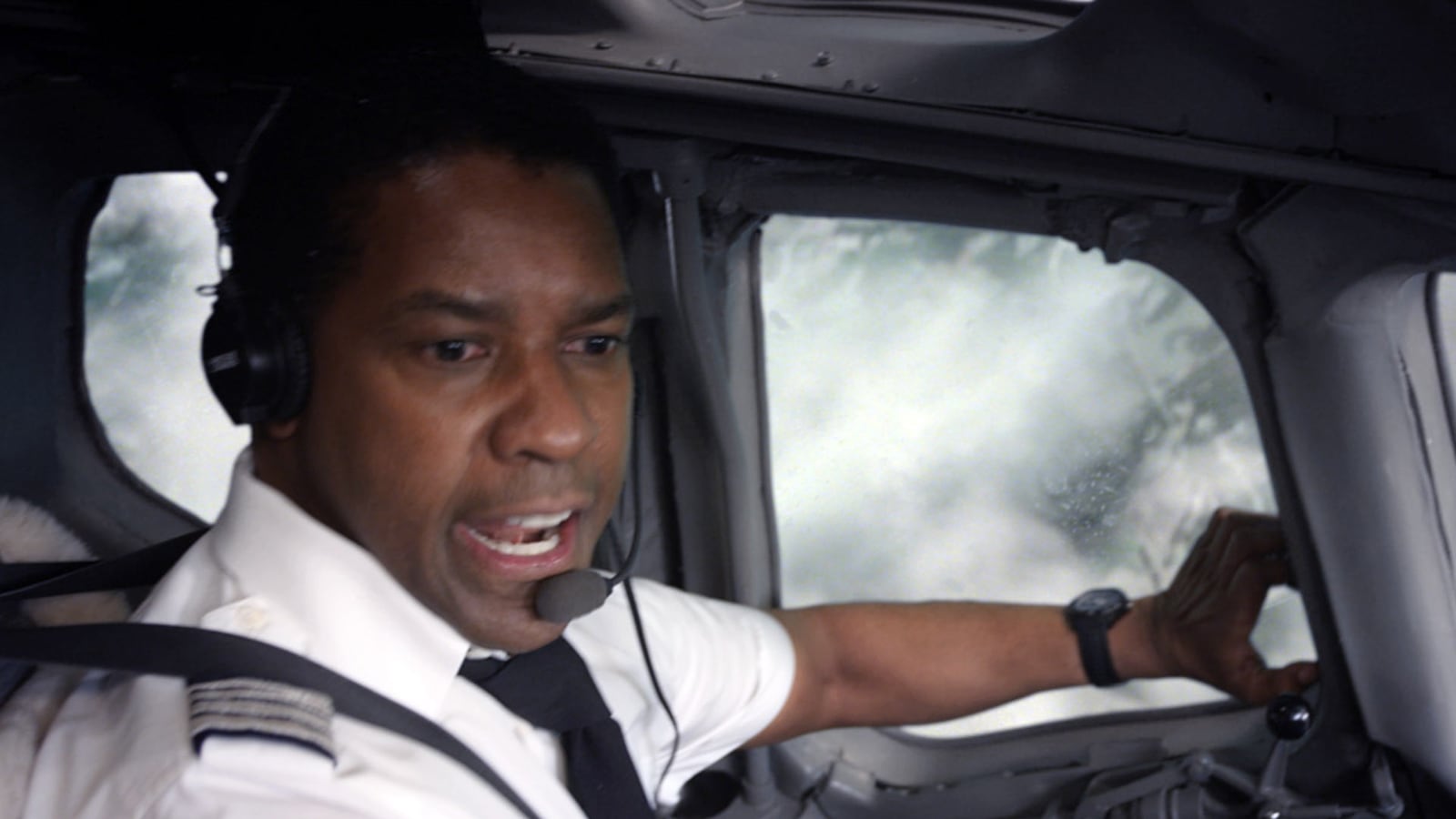
First things first: this isn’t a movie review. I’ll leave that to the professional critics. I’m not Anthony Lane, and any attempts I make at dissecting Flight on its deeper cinematic merits are bound to fall short. Anyway, this isn’t a movie about airplanes or even about pilots, really. (There’s a distinct double meaning to the title, which will make sense to you once you see it.)
[SPOILER ALERT: This article reviews certain plot lines and details.]
I’m more than happy, however, to judge the film on its technical aspects: its cockpit scenes and its portrayal of airline pilots. And what I saw gets a firm thumbs-down.
I went into the theater with an open mind—really, I did. I long ago accepted that when it comes to planes and pilots, Hollywood never gets it right, and I was not expecting anything different this time.
There’s a point, however, where you just can’t let things go. There is nothing funny about Flight, but should you hear howls of laughter coming from the back of the theater, chances are there’s a pilot in the audience. Laughter, if not tears, is the only fair response to much of what the movie shows.
But before getting to the details, first there’s the matter of Denzel Washington’s character, “Whip” Whitaker.
Whip is a hotshot, sauced-up captain whose substance-abuse habit crash-lands him, quite literally, into a whole heap of trouble. Our anti-Sully is a guy who flies on the heels of a coke binge and pours his own cocktails in the galley.
Whip is a cartoon, but the problem is that too many people watching this movie will take him seriously.
The idea that such a reckless pilot might actually exist out there is hardwired into the imagination of the traveling public and unfortunately reinforced by rare but high-profile reports of commercial pilots who’ve been caught while under the influence.
Any number of pilots have indeed battled substance-abuse problems—as have professionals in every line of work—and over the years a much smaller number have been arrested after failing a Breathalyzer or blood-alcohol test. Incidents like these have nurtured a certain apocryphal stereotype: the pilot as hard-drinking renegade, with crow’s-feet flanking his eyes and a whisky-tempered drawl, a flask tucked into his luggage. When the image is so quick to form, it’s tempting to jump to conclusions: for every pilot who’s caught, there must be a dozen others out there getting away with it. Right?
Well, quite frankly, no. Intoxication isn’t something pilots play fast and loose with. Why would we, with our careers on the line? Violators are subject to immediate revocation of their pilot certificates, not to mention potential prison time. I will remind you that pilots are subject to random drug and alcohol testing, and I should also note that simply because a pilot is battling a substance-abuse problem, that does not mean he is flying while drunk or high—and he certainly isn’t mixing drinks in the galley. That is a huge and critical distinction. Passengers worry about all sorts of things, rational and otherwise, but trust me on this one: there’s no Whip Whitaker in the cockpit.
Why not? The rest of us wouldn’t tolerate such a dangerous colleague in our midst, for one thing. Neither would any pilot take the skies with somebody he or she knew to be under the influence. At one point in Flight, Whitaker’s copilot admits from his post-crash hospital bed to having known that his captain was drunk and high even before they’d taken off. Where’s a bucket of tomatoes when you need one?
In other words, a real-life Whitaker wouldn’t survive two minutes at an airline, and all commercial pilots—including, if not especially, those who’ve dealt with drug or alcohol addiction—should feel slandered by his ugly caricature.
The Federal Aviation Administration blood-alcohol limit for airline pilots is 0.04 percent, and we are banned from consuming alcohol within eight hours of reporting for duty. We must also comply with our employers’ in-house policies, which are usually stricter. Drug and alcohol tests are unannounced and common. Air carriers and unions like the Air Line Pilots Association have been very successful with proactive counseling programs that encourage pilots to seek treatment.
Not long ago, I flew with a colleague who participated in the HIMS program, an intervention and treatment system put together several years ago by ALPA and the FAA. HIMS has treated more than 4,000 pilots, with only 10 percent to 12 percent of participants suffering relapse. It has kept alcohol out of the cockpit and has helped prevent the issue from being driven underground, where it’s more likely to be a safety problem. I asked that colleague if, prior to going into HIMS, he’d ever knowingly flown under the influence. His answer was a firm and very believable no.
But back to the movie ...
The workplace dynamic between Whip Whitaker and his copilot, Ken Evans (Brian Geraghty), is another problem. In the cockpit, Whitaker is flip, arrogant, and condescending; Evans is meek and at times frightened and clueless. This is not how actual pilots behave and interact. Further, such a botched depiction only reinforces one of flying’s most irritating myths: the idea of the copilot as a sort of apprentice pilot who is on hand merely to help out and assist the captain.
Copilots are not trainees. I ought to know: I am one. We perform just as many takeoffs and landings as captains do, and we are fully certified to operate the aircraft in all phases of flight. In fact, due to the peculiarities of the seniority bidding that determines almost everything in a pilot’s professional life, it’s not terribly uncommon for the copilot to be older and more experienced than the captain sitting next to him.
The cockpit scenes otherwise range from borderline realistic to preposterous. The checklists, the procedural callouts, the chatter with air-traffic control, etc., are occasionally rendered correctly, if a bit over the top. But mostly they’re peculiar, and at times they are outright silly.
The early-on segment where Whitaker and Evans are battling through a storm is particularly egregious. I cannot begin to describe how wrong it is, from the absurd idea that you would actually increase to maximum flying speed to race between storm cells to Whitaker’s impetuous descent, which for some inexplicable reason he believes will help lead them safely through the weather—all without permission from air-traffic control. Are you kidding?
Minutes later we see the jet, its pitch controls jammed, nosediving unstoppably toward the ground. Whip saves the day by turning the plane upside down, then rolling it right side up again in time for a semisuccessful crash landing in a field. The aerobatic magic here is something that escapes me, but what do I know? I’m just an airline pilot. The sequence is clearly based loosely on the crash of Alaska Airlines 261 in January 2000, when a jammed stabilizer jackscrew forced the McDonnell Douglas MD-83 into an unrecoverable dive. (Whitaker’s plane is a fictionalized version of the same—an MD-90, it looks like to me, with some digitalized winglets attached.) The crew of Alaska Air 261 briefly attempted to regain control by flying inverted. Whatever aerobatic and aerodynamic possibilities exist here aren’t anything I can vouch for. If they do exist, surely Flight has overextended them.
I can let that one go, actually, though I loved it when Whitaker, seconds away from impact, actually radios air-traffic control with the news: “We are in a dive!”
Thanks, Whip. I can only imagine a perplexed controller staring haplessly into a radar screen, not really sure what to say or do, wondering if perhaps he ought to have called in sick that day. In the real world, pilots in the throes of such an emergency wouldn’t be all that worried about what ATC has to say, and such a radio call would be about the last thing on their minds. For most of the film I was too mortified to actually laugh out loud, but that one got a cackle from me.
Presumably, the filmmakers worked with one or more consultants, who must have at least attempted to encourage accuracy. Wikipedia tells us that the late Lyle Shelton, a former stunt pilot, worked as a technical adviser. Perhaps Shelton could have told us more about that upside-down business, but he wasn’t an airline pilot, and it’s the cockpit details—the dramatization of airline SOP—where things fall short. I almost hate to say it, but even Airport ’75—one of the quintessential air-disaster movies, in which Charlton Heston is helicoptered through a hole in a crippled 747—did it better.
I’ll be told, perhaps, that I need to relax, and that the movie ought be judged beyond its technical shortcomings. Normally I would agree, and for the average lay viewer it will hardly matter at all. I’m happy to allow a little artistic license. We should expect it, and some light fudging of the facts can be necessary, to a degree, for a film like this to work. Honestly, I’m not that much of a fussbudget. The trouble with Flight is that the filmmakers seem to have hardly tried.
And why not? Would it really have been that difficult? Would it really have diminished the picture’s storyline or its gravity? I think not.
I’m not sure who gets the bigger screw job here: viewers, who are being lied to, but who may or may not care; airline pilots, whose profession is unrealistically portrayed; or nervous flyers, whose fears this movie will only compound.
I’m not telling you not to see it or not to enjoy it. My complaints notwithstanding, it’s a compelling story that is pretty well told. But remember to bring that proverbial grain of salt.
As for stories about pilots with substance-abuse problems, I prefer the real-life tale of the former Northwest captain Lyle Prouse, whom I wrote about in 2004.
Prouse was one of three Northwest Airlines pilots arrested one morning in Minnesota in 1990. All three had spent the previous evening’s layover at a bar in Fargo, N.D., downing as many as 19 rum and Cokes. Tests showed their blood-alcohol levels far beyond the legal limit.
Prouse, an alcoholic whose parents had died of the disease, became a poster pilot for punishment and redemption. He was sentenced to 16 months in federal prison. Then, in a remarkable and improbable sequence of events, he was able to return to the cockpit on his 60th birthday and retire as a 747 captain.
Once out of jail, Prouse was forced to requalify for every one of his FAA licenses and ratings. Broke, he relied on a friend to lend him stick time in a single-engine trainer. Northwest’s then-CEO, John Dasburg, who himself had grown up in an alcoholic family, took a personal interest in Prouse’s struggle and lobbied publicly for his return.
You’ll see Prouse in interviews from time to time, and inevitably you’ll be struck by how forthrightly he takes responsibility, without resorting to the sobby self-flagellation of most public apologies. Always one is left, unexpectedly, to conclude that this convicted felon deserved his second chance.






